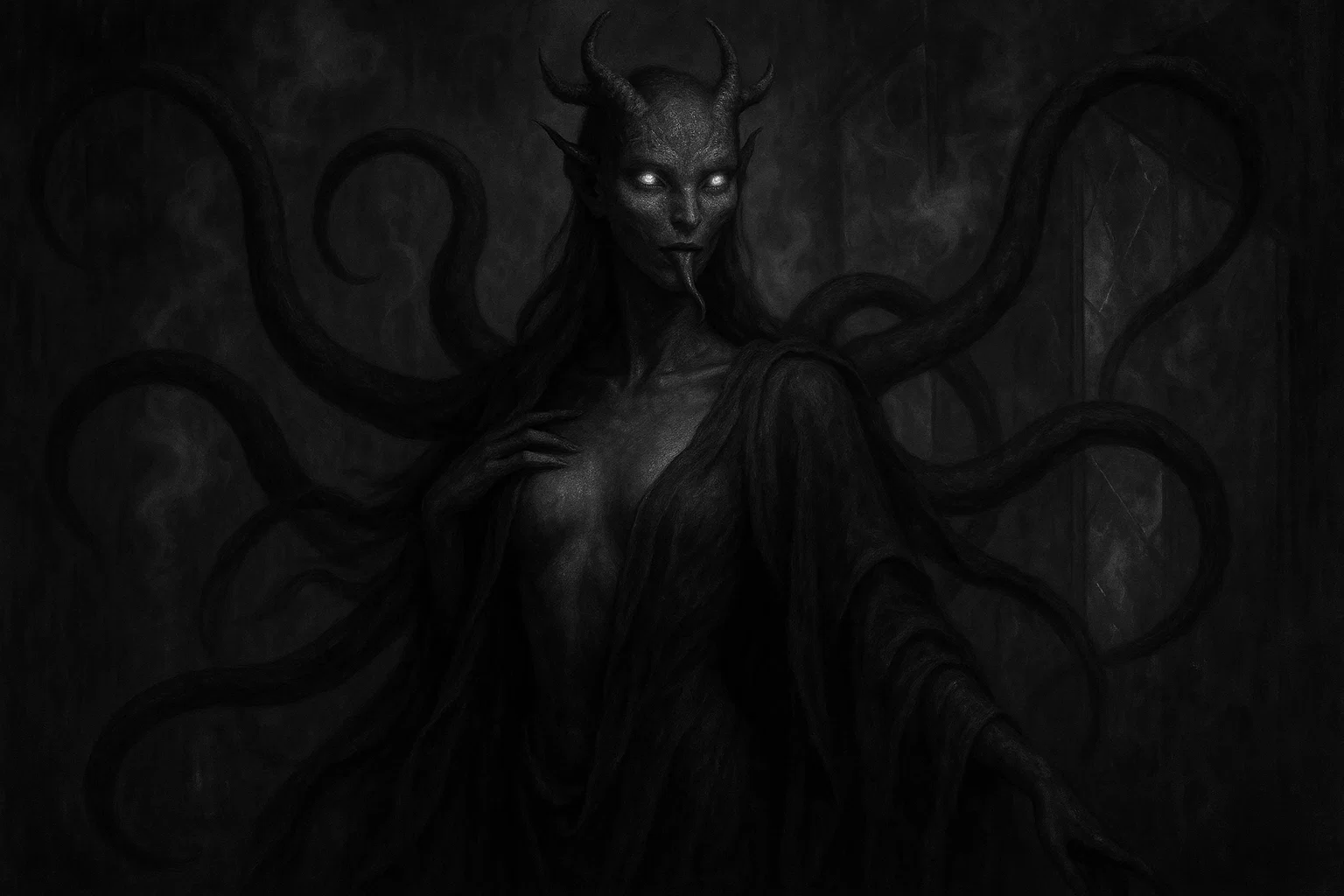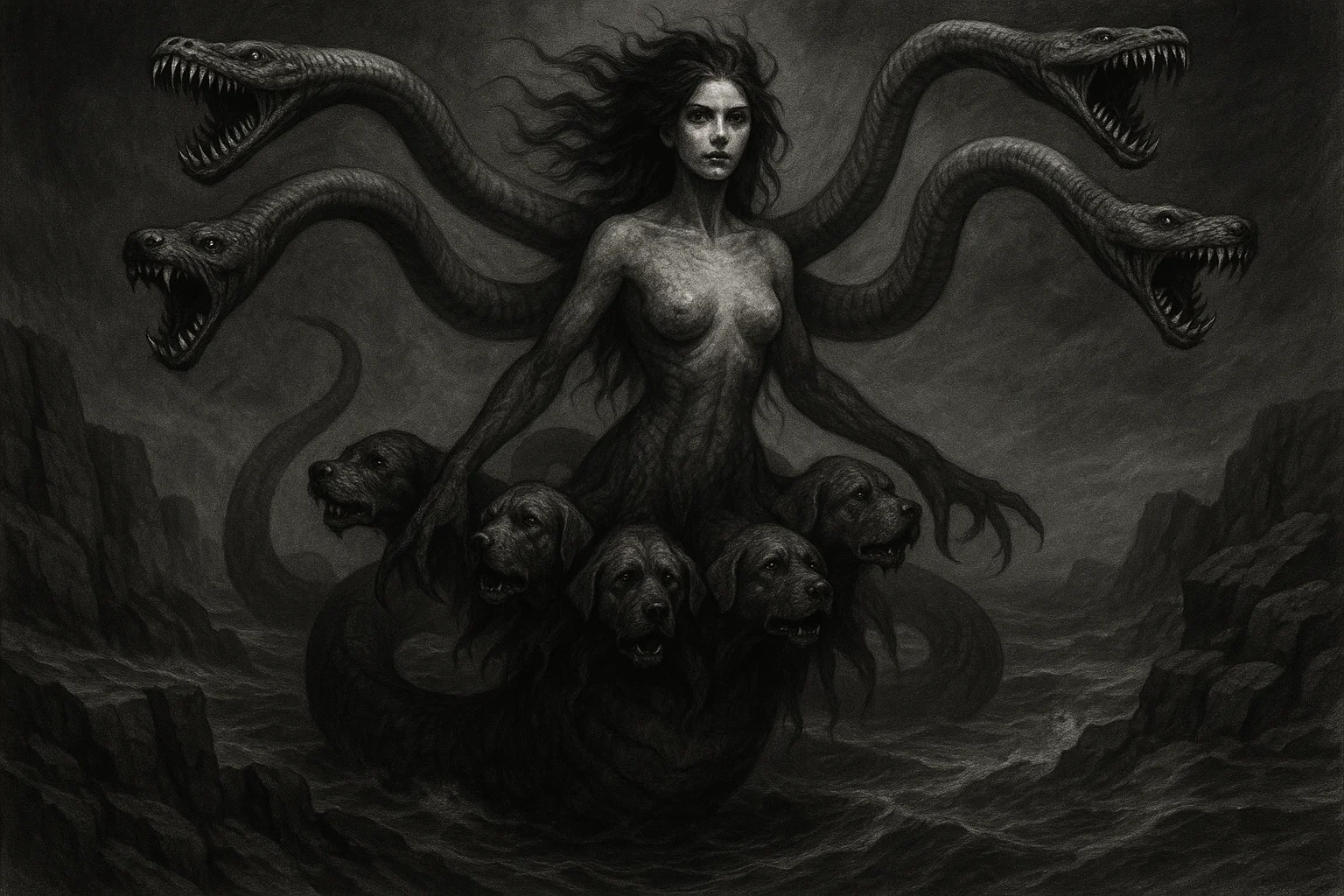In the shadowed realms of Zoroastrian cosmology, where the eternal clash between divine order and chaotic deception unfolds, Aka Manah emerges as a insidious daeva of malevolent intent, a spectral force that preys on the fragility of human thought.
This ancient Persian demon, known for corrupting prophets and warriors alike with whispers of forbidden desires and moral ruin, stands as a chilling embodiment of evil mind and sensual temptation, forever opposing the luminous path of righteousness in the grand narrative of Ahura Mazda’s creation.
As a key antagonist in Iranian mythology, Aka Manah weaves through sacred hymns and epic tales, symbolizing the perilous dance between free will and the allure of darkness.
Summary
Key Information
| Category | Details |
|---|---|
| Name | Aka Manah, Akem Manah, Akoman (Middle Persian), Akvan (New Persian), Evil Mind Daeva |
| Title | Demon of Evil Intention, Daeva of Sensual Desire, Spirit of Wicked Thought, Arch-Fiend of Moral Corruption |
| Gender | Male |
| Role | Corrupter of human minds, tempter of prophets and heroes, sower of deceit and discord, antagonist to cosmic harmony |
| Hierarchy | Arch-daeva, second among Ahriman’s chief creations, lieutenant in the demonic forces opposing Amesha Spentas |
| Servitors | Lesser daevas embodying lust (Varun/Varan), non-peace (Anashtih), and discord; aids collective assaults with entities like Aeshma and Azi Dahaka |
| Superior Demon | Angra Mainyu (Ahriman), the destructive spirit and supreme lord of all daevas |
| Powers | Mental manipulation, induction of sensual desires, posing deceptive questions, blunting moral discernment, propagating illusions of power and discord |
| Appearance | Shadowy and formless essence; in epic depictions, a monstrous figure with long hair, blue eyes, elephant-like head, and tusks; shifts to seductive forms like a beautiful temptress |
| Etymology | Avestan: “akem manah” signifying “evil mind” or “manah made evil”; evolves to Akoman in Pahlavi and Akvan in Persian epics |
| Associated Figures | Zoroaster (tempted victim), Rostam (epic foe as Akvan), Vohu Manah (eternal opponent), Aeshma (wrathful ally), Azi Dahaka (battle comrade), Spityura (joint assailant) |
| Weaknesses | Invocation of Vohu Manah, recitation of Avestan prayers like Ashem Vohu, adherence to Asha through good thoughts, words, and deeds; divine cunning and moral resolve |
| Opposing Angel/Saint | Vohu Manah (Amesha Spenta of good purpose and righteous thought) |
| Equipment/Tools | Whispers of deception, ninety-nine infernal questions, illusions of desire and dominance; no physical arms, but employs perceptual distortions and mental snares |
| Pantheon | Zoroastrianism (ancient Iranian/Persian demonology) |
Etymology
The term Aka Manah originates from the ancient Avestan language, the liturgical medium of Zoroastrian sacred texts, where it dissects into akem and manah. Akem conveys “evil,” “bad,” or “made malevolent,” a transformative prefix that inverts purity into corruption, while manah denotes “mind,” “thought,” “intention,” or “purpose,” capturing the essence of cognitive and volitional faculties.
Thus, akem manah literally renders as “evil mind,” “evil purpose,” “evil thinking,” or “evil intention,” portraying a deliberate perversion of the human psyche toward moral decay and chaotic impulses.
This linguistic construct first surfaces in the Gathas, the primordial hymns ascribed to the prophet Zoroaster, dating to approximately 1500–1000 BCE in the regions of eastern Iran or Central Asia. Here, akem manah manifests not merely as a demonic moniker but as an abstract affliction—a state of being that impedes adherence to Asha, the cosmic principle of truth and order.
Scholars trace its roots to Proto-Indo-Iranian akam manas, paralleling Sanskrit akṛta manas or Vedic notions of corrupted intellect, yet Zoroastrianism uniquely weaponizes it against divine benevolence, marking a theological divergence from Indo-Aryan traditions where manas often signifies neutral or elevated mental states.
As Zoroastrian doctrine matured through the Achaemenid Empire (550–330 BCE), akem manah personified into the daeva Aka Manah, embodying active malice rather than passive flaw.
In Middle Persian Pahlavi scripts of the Sassanian period (224–651 CE), it morphs into Akoman, retaining phonetic fidelity while integrating into cosmological narratives like the Bundahishn, where it opposes Vohu Manah—the “good mind.” This evolution reflects linguistic shifts: Avestan aspirates soften, and conceptual abstractions solidify into hierarchical entities, as seen in the Denkard‘s expositions on demonic influences.
By the Islamic era, New Persian adaptations yield Akvan, evident in Ferdowsi’s Shahnameh (circa 1010 CE), where the name evokes epic monstrosity amid Persian cultural synthesis. Etymologists link manah to broader Indo-European cognates like Greek ménos (“spirit” or “rage”) and Latin mens (“mind”), underscoring a shared ancestral lexicon for mental states.
However, Zoroastrianism’s dualistic lens refracts akem as an inversion, distinguishing Aka Manah from benign counterparts and aligning it with related terms like aka mainyu (“evil spirit”)—a near-synonym but focused on instrumental malice—and angra mainyu (“destructive spirit”), the overarching evil force.
Further depth reveals semantic nuances: akem manah equates to acishtem manah (“worst thinking”) in Gathic contrasts, emphasizing gradations of depravity. In ritual contexts, invoking the name served apotropaic functions, warding against its influence through prayers that exalt vohu manah.
Linguistic analyses from 19th-century philologists like James Darmesteter highlight how akem derives from aka-, a root implying “crooked” or “perverse,” mirroring the daeva’s role in twisting righteous paths. This etymological richness not only anchors Aka Manah in Zoroastrian demonology but also illustrates the religion’s profound emphasis on mental purity, where language itself becomes a battleground for cosmic forces.
Comparative linguistics extends connections: in Old Persian inscriptions of Darius I (522–486 BCE), echoes of moral dualism appear, though not explicitly naming Aka Manah. In Armenian folklore, borrowed from Persian, analogous terms like aknamah suggest cultural diffusion.
Ultimately, the name’s progression—from abstract vice in nomadic Iranian tribes to a vivid infernal antagonist in imperial scriptures—mirrors Zoroastrianism’s adaptation across millennia, from oral traditions in Bactria to codified texts in Persepolis, cementing Aka Manah as a timeless emblem of intellectual corruption.
You May Also Like: The Dark Demon Seth: God of Chaos in Egyptian Mythology
What Does Aka Manah Look Like?
Aka Manah eludes a fixed corporeal presence, manifesting primarily as an intangible miasma of deceit that infiltrates the human consciousness, a formless shadow that twists perceptions without revealing itself.
In Zoroastrian scriptures, this daeva’s essence is spectral, a swirling vortex of dark impulses that cloaks itself in illusions tailored to the victim’s weaknesses—perhaps a fleeting vision of opulent thrones for the ambitious or seductive silhouettes for the lustful. This ethereal nature aligns with its role as a mental corrupter, emphasizing psychological terror over physical menace.
When later traditions attempt visualization, Aka Manah assumes grotesque and mutable forms to evoke revulsion and allure in equal measure.
In New Persian epics like the Shahnameh, as Akvan, it appears as a hulking abomination with long, disheveled hair cascading like tangled vines, piercing blue eyes gleaming with cold malice, and a head grotesquely elephantine, complete with jagged tusks protruding where teeth should be—a hybrid monstrosity symbolizing brute deception. Its skin might shimmer unnaturally, pale and veined with shadows, while elongated limbs or tendrils extend to grasp and ensnare, evoking a predator’s calculated embrace.
Occasional depictions in esoteric Persian art portray Aka Manah shifting into beguiling guises, such as a radiant temptress with flowing robes and enchanting features, designed to lure the unwary into moral downfall. Horns curve subtly like withered branches, and a forked tongue darts from smirking lips, underscoring its serpentine cunning. Devoid of conventional armor or blades, its aura exudes a chilling fog scented with decayed incense, a sensory assault that disorients and corrupts.
This variability reinforces Zoroastrian warnings: the daeva’s true horror resides in its adaptability, mirroring the viewer’s inner demons to exploit vulnerabilities relentlessly.
Historical and Mythological Background
Zoroastrianism, emerging around 1500 BCE in the vast expanses of ancient Iran—likely in regions like Bactria or Aria—presents a profound dualistic framework where Ahura Mazda, the wise creator of light and truth, eternally contends with Angra Mainyu (Ahriman), the destructive spirit of chaos and lies. Aka Manah, as a principal daeva, originates from this cosmic antagonism, crafted by Ahriman to parody and undermine the benevolent Amesha Spentas, the immortal holy ones.
Historical records trace its conceptualization to the Gathas, Zoroaster’s hymns, where it begins as an abstract vice before evolving into a personified entity in later Avestan texts during the Achaemenid era (550–330 BCE), when Zoroastrianism became the state religion under rulers like Cyrus the Great.
The daeva’s roots intertwine with Proto-Indo-Iranian beliefs, sharing linguistic and thematic ties with Vedic demons in ancient India, such as those embodying mental afflictions in the Rigveda (circa 1500 BCE). Potential connections span worldwide: similarities to the Buddhist Mara, the tempter of Siddhartha Gautama (5th century BCE), who assaults with illusions of desire; or the Mesopotamian Lilitu (Lilith prototypes, 2000 BCE), spirits of seduction and moral peril.
In Judeo-Christian traditions, echoes appear in Asmodeus from the Book of Tobit (3rd–2nd century BCE), a demon of lust and wrath, or even Satan as the adversary tempting with forbidden knowledge. Greek influences during the Hellenistic period (post-330 BCE) might link it to Eris, goddess of discord, while in Egyptian mythology, Apophis—the chaos serpent—mirrors its oppositional role against order.
These cross-cultural parallels suggest diffusion via trade routes like the Silk Road, where Persian demonology influenced neighboring pantheons, though Aka Manah remains distinctly Zoroastrian in its focus on intellectual corruption.
By the Sassanian Empire (224–651 CE), Pahlavi texts like the Bundahishn solidify Aka Manah‘s (as Akoman) place in eschatological lore, amid persecutions and codifications that preserved Zoroastrianism against rising Islam. Post-conquest, it persists in Persian folklore, blending with Islamic jinn or pre-Islamic divs in epics, reflecting cultural resilience in diaspora communities from India to Central Asia.
You May Also Like: The Demon Ammit: Crocodile-Headed Devourer of the Dead
The Temptation of Zoroaster
This legend, detailed in the Vendidad (Fargard 19), a Younger Avestan compilation of purity laws and demonology from circa 1000–500 BCE, recounts Zoroaster’s divine trial near the Daiti River in ancient Iran.
Fresh from his revelation at age 30, where he envisioned Vohu Manah and the Amesha Spentas while drawing water for a haoma ceremony, the prophet becomes Ahriman’s target. Angra Mainyu dispatches Aka Manah as the third assailant in a nocturnal ambush, armed with a hundred infernal designs to erode faith.
Aka Manah confronts Zoroaster with ninety-nine cunning questions, each a barbed probe into devotion: promises of earthly dominion, sensual ecstasies, and seeds of doubt about Ahura Mazda’s justice and the efficacy of Asha.
These queries, laced with illusions of power and pleasure, aim to fracture the prophet’s conviction, exploiting moments of solitude to amplify inner turmoil. Zoroaster, guided by Vohu Manah’s luminous insight, rebuffs each temptation, reciting sacred mantras like the Ahunavar to affirm unyielding allegiance to truth.
The daeva’s failure culminates in retreat at dawn, as Zoroaster’s prayers invoke Atar’s purifying fire, scorching the shadows. This event, set against the backdrop of Iranian plains, symbolizes humanity’s triumph over internal demons, influencing later Zoroastrian rituals where fire temples echo these recitations.
Expanded in Pahlavi rivayats (9th century CE), it portrays Aka Manah‘s approach as a whispering gale, with the prophet’s resolve turning deception back upon the daeva, a motif of divine cunning.
Battle for the Khvarenah
Chronicled in the Zamyad Yasht (Yasht 19), a hymn to divine glory dated to circa 500 BCE, this myth depicts a celestial skirmish for khvarenah—the radiant force of sovereignty and victory—over sacred mountains like Hara Berezaiti. Ahriman rallies Aka Manah alongside Aeshma (wrath demon), Azi Dahaka (three-headed dragon-serpent tyrant, chained in Damavand), and Spityura (white demon, slayer of Yima) to seize this essence from the Amesha Spentas.
Aka Manah unleashes mental veils of despair and illusion, clouding Vohu Manah’s clarity, Asha Vahishta’s righteousness, and Atar’s sacred fire.
The battle rages across ethereal realms, with Aka Manah‘s tendrils ensnaring the glory’s light, promising false victories to divine champions. Yet, the Amesha Spentas counter: Vohu Manah pierces the deception with pure thought, Asha Vahishta shatters lies with truth’s blade, and Atar incinerates the shadows.
The yasht prophesies a rematch at Frashokereti, the world’s renovation, where Aka Manah faces Vohu Manah in ultimate defeat. Invoked in Achaemenid coronations, this legend underscores Aka Manah‘s threat to leadership, corrupting kings’ minds to sow empire-wide chaos, while affirming eschatological hope.
You May Also Like: Utukku: The Faceless Shadow Demon of Mesopotamia
Role in the End of Days
In Sassanian eschatology, elaborated in the Bundahishn (9th century CE), Aka Manah (Akoman) amplifies sins during the 3,000-year struggle’s final assault. As Ahriman’s second creation, it swells humanity’s “evil mind,” fostering greed, envy, and wrath until atrocities rupture Azi Dahaka’s chains, unleashing winter and terror.
Aka Manah‘s whispers erode reverence for religion, family, and elders, darkening sun and moon, plunging the world into moral winter. At Frashokereti, Saoshyant—the savior born of Zoroaster’s seed—purifies existence, consigning Aka Manah and daevas to molten metal’s torment.
Echoed in medieval Persian poetry, Aka Manah (as Akvan) hurls heroes into trials, symbolizing collective temptation’s peril and virtue’s redemption.
Assault on Zoroaster’s Birth
From the Epistles of Zadspram (9th–10th century CE), this pre-birth assault positions Aka Manah (Akoman) as the first demon targeting Zoroaster. Before conception, it injures the prophet in utero; at birth, it frightens the infant with apocalyptic visions, inducing cries symbolizing dread.
Vohu Manah intervenes with cunning, luring Aka Manah away, turning its malice inward. This narrative, set in Iranian villages, highlights demonic preemption of divine saviors.
Historical Mentions
| Text/Grimoire | Year | Description | Excerpt |
|---|---|---|---|
| Yasna (Gathas, part of Avesta) | c. 1500–1000 BCE | Aka Manah as akem manah, human attribute of disobedience and deceitful motivation, property of daevas as their offspring. | “Through worship, I shall counter my own disobedience and aka manah.” (Yasna 33.4) |
| Yasna (Gathas, part of Avesta) | c. 1500–1000 BCE | Aka Manah (Akoman) as the second of Ahriman’s creatures, opposing Vohu Manah; collaborates with Anashtih and Varun. | “Aka manah is the motivation that causes deceitful actions.” (Yasna 47.5) |
| Yasna (Gathas, part of Avesta) | c. 1500–1000 BCE | Aka Manah causes deceitful actions, abode of the wicked, as acishtem manah. | “The daevas… are offspring of aka manah… they have chosen not rightly.” (Yasna 32.3) |
| Vendidad (Fargard 19, Avesta) | c. 1000–500 BCE | Aka Manah (Akoman) blunts decisions, causes evil intent, induces discord, and frightens infants with apocalyptic visions. | “Aka Manah came to him the third time… with a hundred infernal designs.” (Vendidad 19.1–5) |
| Zamyad Yasht (Yasht 19, Avesta) | c. 500 BCE | Daevas as offspring of Akem Manah, not beloved, chosen wrongly with evil knowledge. | “Aka Manah, the wicked, Aeshma… rushed against it.” (Yasht 19.46) |
| Bundahishn (Pahlavi text) | 9th century CE | Aka Manah tempts Zoroaster with ninety-nine questions to weaken his faith. | “Akoman is the second of the fiends… opposing the good mind.” (Bundahishn 1.24) |
| Denkard (Pahlavi encyclopedia) | 9th–10th century CE | Aka Manah (Akoman) blunts decisions, causes evil intent, induces discord, frightens infants with apocalyptic visions. | “Akoman causes failure to discriminate good from evil… introducing discord.” (Denkard 9.30.8) |
| Epistles of Zadspram (Pahlavi) | 9th–10th century CE | Aka Manah assaults Zoroaster before and at birth, defeated by Vohu Manah’s cunning. | “Akoman was the first to come against him… Vohuman lured him away.” (Zadspram 14.8) |
| Shahnameh (New Persian epic) | c. 1010 CE | Aka Manah (Akvan) as monstrous div, traps and hurls Rostam, ultimately beheaded. | “Akvan lifted him… asked mountain or sea… threw him into the water.” (Shahnameh excerpt) |
You May Also Like: Who Is Hanbi? The Formless Demon of Ancient Mesopotamia
Aka Manah’s Powers and Abilities
Aka Manah commands an arsenal of insidious faculties tailored to subvert the human spirit, distinguishing itself through precision in psychological assault rather than overt destruction common to lesser daevas. As the daeva of evil intention, it excels in implanting wicked thoughts, blurring ethical boundaries to foster self-deception and societal fracture.
In Zoroastrian texts, Aka Manah corrupts by exploiting vulnerability—such as during ethical dilemmas or solitary reflections—whispering visions of illicit gains that masquerade as personal ambition, leading victims to rationalize betrayal or indulgence as inevitable.
Unlike generic demons unleashing plagues or fury, Aka Manah‘s uniqueness resides in consensual corruption; it engineers apparent autonomy in downfall, making the tempted complicit. For instance, it might afflict a leader with illusions of unchallenged rule, eroding alliances through hubris, or a devotee with sensual cravings that prioritize carnality over spiritual duty.
At cosmic scales, its influence hastens eschatological chaos, amplifying collective sins to unchain tyrants like Azi Dahaka. Yet, its powers wane against fortified minds, as Zoroaster’s resistance demonstrates, underscoring Zoroastrianism’s optimism in moral agency.
Expanded lore from Pahlavi sources reveals Aka Manah blunting righteous discernment, inducing “gross defects” in perception where flaws remain hidden while others are magnified. It frightens newborns with end-time visions, planting lifelong seeds of dread, and perverts thoughts into physical evils like discord or lust.
In epic confrontations, its deceptive queries—ninety-nine in number—probe convictions, tempting with tailored illusions that exploit personal vices, ensuring corruption feels organic rather than imposed.
| Power/Ability | Description | Source | How It Tempts/Corrupts Humans |
|---|---|---|---|
| Mental Manipulation | Implants deceitful thoughts, distorts perception of good/evil, hides personal flaws. | Denkard 3.255, 9.30.8 | Leads to self-justified betrayals, fostering envy and isolation. |
| Deceptive Questioning | Poses ninety-nine queries to undermine faith and moral conviction. | Vendidad 19 | Exploits doubts, turning resolve into hesitation and apostasy. |
| Sensual Desire Induction | Awakens lustful urges, prioritizing flesh over duty. | Bundahishn 1.24 | Corrupts purity, breeding addictions that shatter familial bonds. |
| Illusion of Power | Projects false visions of dominance and gain. | Zamyad Yasht 19.46 | Inflates ego in leaders, inciting tyranny and fractured societies. |
| Discord Propagation | Amplifies suspicion, introduces non-peace and conflict. | Denkard 3.33, 6 | Sows feuds, eroding communal harmony through whispered mistrusts. |
| Apocalyptic Fright | Inflates the ego in leaders, inciting tyranny and fractured societies. | Denkard 8 | Cultivates chronic dread, weakening resistance to future sins. |
| Moral Blunting | Dullness’s ability to discern righteousness causes evil intent. | Denkard 3.116 | Rationalizes atrocities, turning ethical lapses into habits. |
How to Counter Aka Manah’s Powers
Deflecting Aka Manah‘s insidious grasp requires unwavering mental fortitude, rooted in Zoroastrian principles of good thoughts (humata), words (hukhta), and deeds (hvarshta).
Primary is the invocation of Vohu Manah, the opposing Amesha Spenta, through meditative focus on pure intentions during crises, as Zoroaster did to repel deceptive queries. Reciting core prayers like the Ashem Vohu—”Righteousness is the best good”—acts as a sonic barrier, its rhythmic repetition clearing mental fog and reaffirming Asha.
Ritual practices enhance resistance: maintaining sacred fires (atar) in homes symbolizes purification, its flames historically believed to burn away daevic illusions, as in the Zamyad Yasht battles.
Consecrated water from rivers, evoking Zoroaster’s Daiti vision, cleanses the body and mind, washing off perceptual distortions. Communal Yasna ceremonies, with haoma libations, unite participants in harmonious chants, overwhelming solitary temptations with collective strength.
Ethical vigilance starves the daeva: acts of charity, animal husbandry, and truth-telling affirm life’s sanctity, countering discord and lust. Wearing the sudreh and kusti during trials binds one to Ahura Mazda, a tactile reminder against whispers. In folklore, cunning inversion—echoing Vohu Manah’s lure in the Epistles of Zadspram—turns deception back, transforming temptation into self-revelation.
Ultimately, awareness of its subtlety fortifies; recognizing patterns of doubt as daevic interference empowers rejection, converting peril into spiritual growth.
You May Also Like: Bigfoot: What Are We Still Missing?
Aka Manah’s Role in the Hierarchy of Hell
Zoroastrian “hell” (Druj-demana, house of lies) is a frigid abyss of remorse, not flames, where souls endure self-inflicted torment mirroring earthly sins.
Aka Manah commands a premier rank as an arch-daeva, second in Ahriman’s creations per the Bundahishn (1.24), devised to mock Vohu Manah and sabotage intellectual order. This positioning in Sassanian texts (9th century CE) mirrors the Amesha Spentas’ structure, with Aka Manah as the mental counterpart to good purpose.
As Ahriman’s strategist, it directs psychic offensives, outranking minions like pairika seductresses but yielding to Ahriman’s supremacy.
Collaborators (hamkars) include Anashtih (non-peace) and Varun (lust), per Denkard 3.33, forming triads for corruption. Relationships are tense: alliances with Aeshma in wrathful assaults (Zamyad Yasht 19.46), rivalries with Saurva over anarchy, all subservient in anti-Spenta campaigns.
In the Epistles of Zadspram (14.8), Aka Manah leads pre-birth attacks on Zoroaster, highlighting its vanguard status. The Denkard deems it most dreaded (9), for perverting discernment and inducing discord (3.116, 6). Eschatologically, its defeat at Frashokereti (Yasht 19.96) signals hell’s collapse, a demotion to annihilation, emblematic of dualism’s symmetry where evil’s architects face dissolution.
Astrological Associations and Symbolism
Though Zoroastrianism views stars as Ahrimanic corruptions, Aka Manah links to malefic celestial forces, distorting intellect. Aligned with Mercury (Tīr), twisted into deceit, it governs communication’s shadow—lies and intrigue—evoking Gemini’s duality, where adaptability turns to cunning traps. This association, from Pahlavi texts, underscores mental turbulence in astrological charts.
Symbolically, Aka Manah ties to air’s erratic element, number 9 (ninety-nine temptations, perverting harmony’s 6), and lead—Saturn’s (Kēwān) heavy metal burdening the soul. Black tourmaline absorbs its negativity,and indigo veils illusions against Vohu Manah’s gold. In rituals, amber incense dispels vapors, while 99 evokes cyclical snares.
Broader symbolism includes serpents for deception, fractured eyes for blinded judgment, wilted lotuses for decayed purity. These avert its influence, reinforcing Zoroastrian dualism’s celestial-moral interplay.
| Association | Details | Symbolic Meaning |
|---|---|---|
| Element | Air (unseen, turbulent force) | Intellectual chaos, invisible malice |
| Number | 9 (ninety-nine questions) | Endless temptation cycles, near-fall |
| Metal | Lead | Soul’s heavy corruption, inversion |
| Stone/Crystal | Black tourmaline | Negativity absorption, deceit grounding |
| Color | Indigo (twilight veil) | Illusion boundary, light/dark merge |
| Zodiac Influence | Gemini (Mercury’s duality) | Duplicitous traps, mental adaptability |
| Planet | Mercury (Tīr, twisted) | Deceptive communication, intellect’s shadow |
You May Also Like: The Edge of Nothing | Horror Story
Aka Manah’s Sigil
Absent a canonical sigil in aniconic Zoroastrianism, protective inversions like the faravahar wards substitute. Esoteric traditions imagine a coiled serpent-pierced fractured eye, etched for banishment, channeling Vohu Manah’s clarity. In rituals, this glyph, murmured in Avestan, binds the daeva.
Modern occult adaptations stylize “akem” as a thorned spiral, evoking entrapment. Priests favor indirect symbols—shattered kusti or dimmed flames—to denote without summoning.
| Symbol/Item | Association/Meaning | Use in Rituals |
|---|---|---|
| Serpent Coil | Deceptive embrace, perpetual temptation | Salt-drawn for warding circles |
| Fractured Eye | Moral blindness, judgmental distortion | Burned in Yasna for illusion clearance |
| Black Amber Incense | Mental poison absorption | Burned in yasna for illusion clearance |
| Wilted Lotus | Purity’s corruption, desire’s decay | Aversion offerings for purification |
| Raven Feather | Doubt’s messenger, shadowy omens | Amulets against psychic assaults |
| Lead Amulet | Burden of evil intent | Worn to reflect malice back |
| Indigo Veil | Boundary of deception | Draped in prayers for clarity |
Comparison with Other Demons
| Demon | Origin/Pantheon | Primary Power/Temptation | Key Difference from Aka Manah | Shared Trait |
|---|---|---|---|---|
| Aeshma | Zoroastrianism | Wrathful violence with bloody mace | Overt rage vs. subtle mind tricks | Ally in daevic battles |
| Indra (as daeva) | Zoroastrianism | Deception of rulers, inducing apostasy | Targets elite vs. universal psyches | Opposes Amesha Spentas |
| Saurva | Zoroastrianism | Tyrannical anarchy and disorder | Societal chaos vs. personal vice | Counters divine harmony |
| Naonghaithya | Zoroastrianism | Stubborn pride, rebellious defiance | Emotional resistance vs. intellectual | Undermines devotion |
| Taurvi | Zoroastrianism | Bodily aging, physical degradation | Corporeal decay vs. mental rot | Attacks immortality aspects |
| Zairicha | Zoroastrianism | Moral weakening, inducing failure | Passive defeat vs. active intent | Promotes human downfall |
| Asmodeus | Judeo-Christian | Lustful vengeance, marital disruption | Romantic obsession vs. broad desire | Tempts sages and prophets |
| Lilith | Mesopotamian/Jewish | Seductive harm to infants, independence | Feminine rebellion vs. masculine mind | Embodies forbidden allure |
| Mara | Buddhism | Cravings and illusions during enlightenment | Sensory delusions vs. ethical doubts | Obstructs spiritual paths |
| Belial | Judeo-Christian | Lawlessness, worthless deceit | Anarchic rebellion vs. intentional evil | Corrupts through lies |
| Iblis | Islam | Refusal and temptation of Adam | Prideful disobedience vs. thought perversion | Leads astray from divine will |
| Apophis | Egyptian | Chaos serpent, eternal night | Physical disorder vs. psychic traps | Opposes cosmic order |
| Eris | Greek | Discord and strife among gods/mortals | External conflict vs. internal mind | Sows seeds of division |
You May Also Like: The Werewolf of Morbach: Truth or Terrifying Legend?
Conclusion
Aka Manah persists as a formidable archetype in Zoroastrian demonology, a daeva whose mastery over evil thoughts illuminates the religion’s dualistic essence: the perpetual strife where corrupted intentions forge chains of chaos.
From seducing Zoroaster to battling for divine glory, this entity epitomizes the hazard of unbridled desires, compelling believers to guard their minds against the insidious creep of deceit. Its narrative, spanning ancient hymns to epic confrontations, reinforces that evil’s strength lies in subtlety, yet yields to resolute virtue.
In contemporary reflections, Aka Manah‘s influence resonates in discussions of cognitive biases and ethical quandaries, a timeless reminder of internal battles amid external turmoil. Zoroastrian dualism provides enduring wisdom: through vigilant thoughts and righteous actions, even the craftiest daeva’s shadows dissipate.
Ultimately, confronting Aka Manah‘s lore cultivates fortitude, alchemizing dread into enlightenment. As night falls, the faithful affirm: good mind conquers, a radiant shield against the abyss, transforming the daeva’s opposition into a catalyst for profound spiritual allegiance.







